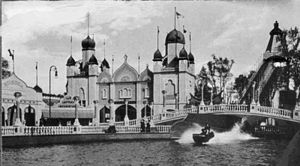- Luna Park, Cleveland
-
For other amusement parks known by the same name, see Luna Park.
 Post card (~1910) picture of the main entrance of Luna Park, Cleveland. A victim of the Great Depression, the park closed its gates in 1929.
Post card (~1910) picture of the main entrance of Luna Park, Cleveland. A victim of the Great Depression, the park closed its gates in 1929.
 View of Luna Park, Cleveland's shoot-the-chutes ride, ca. 1910. Note the sign for the "10¢ Infant Incubators" in the background.
View of Luna Park, Cleveland's shoot-the-chutes ride, ca. 1910. Note the sign for the "10¢ Infant Incubators" in the background.
Luna Park was an amusement park in Cleveland, Ohio, USA, from 1905 to 1929.[1] Constructed by Frederick Ingersoll, the park occupied a hilly 35-acre (140,000 m2) site bounded by Woodland Avenue, Woodhill, Mt. Carmel, and East 110th Street and included roller coasters, carousels, a fun house, a Ferris wheel, a roller rink, a shoot-the-chutes ride, a concert shell, a dance hall, bumper cars, a baseball field,and a 20,000-seat[2] stadium (unofficially called "Luna Bowl", destroyed by 1929 fire) in which American football was played.[3] On May 18, 1905, Cleveland's Luna Park became the second Ingersoll park of that name (out of 44)[3][4] to have opened before his death in 1927, and the second amusement park (after Luna Park, Pittsburgh, which opened weeks earlier) to be covered with electrical lighting.[4]
The monetary demands of upgrading and maintaining his embryonic chain of amusement parks forced Ingersoll, the original owner of Cleveland's Luna Park, to declare bankruptcy in 1908;[5] Ingersoll was forced to sell his Cleveland park[3][6] to Matthew Bramley, an original investor in (and, later, owner of) Ingersoll's Luna Park Amusement Company who built the Cleveland Trinidad Paving Company into the largest paving company in the world.[7] Bramley added rides to Luna Park as its popularity as a trolley park grew, in part because beer was sold on the park grounds.[3] After the passage of the Eighteenth Amendment to the United States Constitution and the beginning of Prohibition (1920), a primary source of revenue was removed as the park's popularity waned. Bramley officially closed the gates to Luna Park in 1929 for the final time as the Great Depression took hold in the United States. The park was beset with incidences of arson, including the fire that destroyed the football stadium), and most of the rides were dismantled and moved to other amusement parks in the early 1930s.
The Cleveland Panthers of the first American Football League and the Cleveland Bulldogs of the National Football League played their home games in Luna Bowl,[2] and (after the dismantling of the amusement rides had begun) Negro League baseball teams Cleveland Stars (1932), Cleveland Giants (1933), and Cleveland Red Sox (1934) each played their home games at the ballfield that was originally adjacent to the football stadium.[8] On December 12, 1938, the last vestige of the park, the skating rink, was destroyed by fire. In 1940, the Woodhill Homes housing development was built on the park site.
References
- ^ History of the West Park Neighborhoods
- ^ a b Murray Greenberg, Passing Game: Benny Friedman and the Transformation of Football (PublicAffairs 2008) ISBN 158648477X
- ^ a b c d Luna Park article from The Encyclopedia of Cleveland History
- ^ a b Luna Park's luminary: Entrepreneur/roller coaster designer deserves his due - Pittsburgh Post-Gazette, 1 September 2008
- ^ Jim Futrell, Amusement Parks of Pennsylvania (Flagpole Books, 2002) ISBN 0811726711
- ^ Timeline: A Publication of the Ohio Historical Society (The Society 2005)
- ^ Matthew Frederick Bramley entry in Encyclopedia of Cleveland History
- ^ Negro League Ballparks
External links
Coordinates: 41°29′23″N 81°36′42″W / 41.48972°N 81.61167°W
Owners C. X. ZimmermanHead Coaches Roy WattsStadia Luna BowlSeasons Notable players Ohio League Teams Akron East Ends • Akron Indians • Canton Bulldogs • Cincinnati Celts • Cleveland Panthers • Cleveland Tigers • Coleman Athletic Club • Columbus Panhandles • Dayton Triangles • Detroit Heralds • Elyria Athletics • Franklin Athletic Club of Cleveland • Ironton Tanks • Massillon Tigers • Shelby Blues • Shelby Tigers • Toledo Maroons • Youngstown PatriciansStadia Armory Park • Idora Park • Indianola Park • League Field • League Park • League Park • Luna Bowl • Swayne Field • Tank Stadium • Triangle ParkRelated topics Canton Bulldogs–Massillon Tigers betting scandal • Nesser BrothersAmerican Football League (1926) Seasons Teams Stadia Browning Field • Braves Field • Comiskey Park • Commercial Field • Davids' Stadium • Douglas Park • Fenway Park • Luna Bowl • Sesquicentennial Stadium • Yankee StadiumCategories:- Amusement parks in Ohio
- Culture of Cleveland, Ohio
- Defunct amusement parks in the United States
- Defunct American football venues
- American Football League (1926) venues
- Defunct baseball venues
- History of Cleveland, Ohio
- Sports venues in Cleveland, Ohio
- 1905 establishments in the United States
- 1929 disestablishments
Wikimedia Foundation. 2010.
